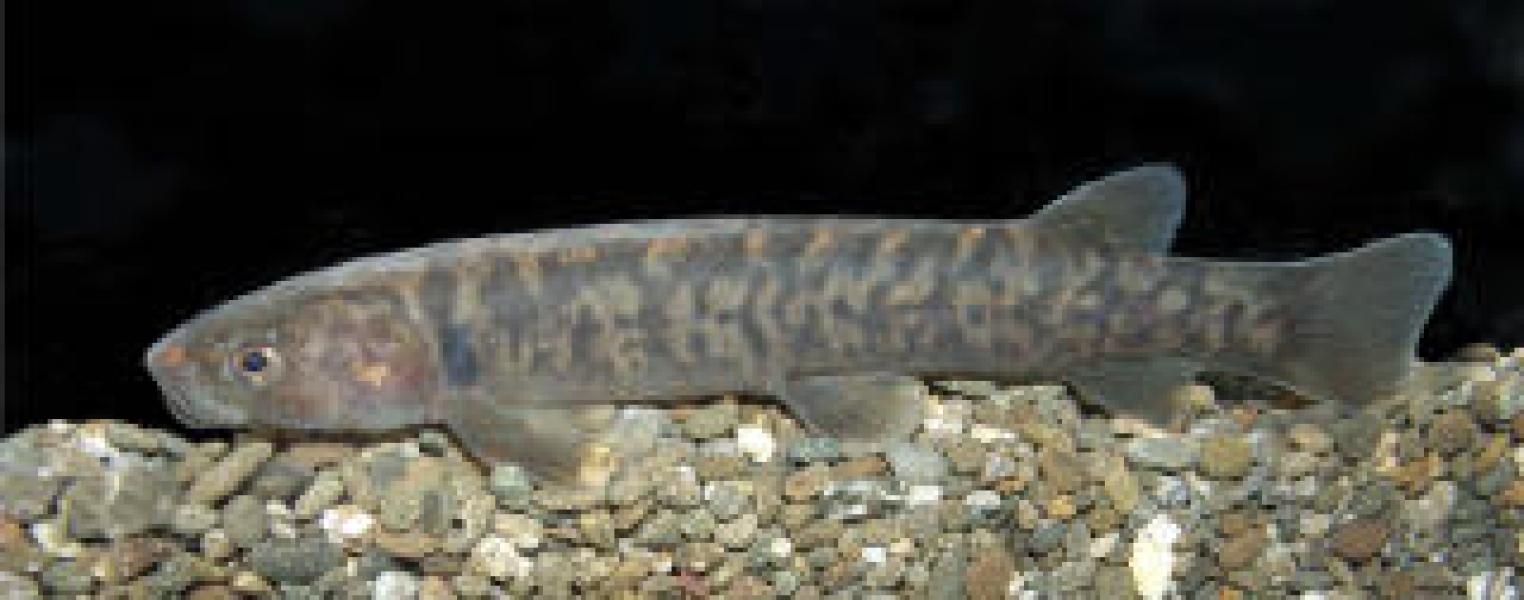Kōaro are excellent climbers and like clear, swiftly flowing, forested streams.
Common name: Kōaro Scientific name: Galaxias brevipinnis Māori names: includes kōaro
About this species
Kōaro are excellent climbers and able to penetrate further inland than any of the other whitebait species. Adult kōaro are not easily confused with other galaxiid species as they have larger pectoral fins and more elongated and tubular body forms. Although kōaro are part of the whitebait run, they can also form land locked populations where they are able to complete their entire lifecycle in a lake. Managing populations of kōaro is difficult at present as little is known about their spawning grounds. In rivers, kōaro tend to occur in high velocity rapids with boulder substrates and they require forested streams.
Traditional knowledge
Kōaro were an important food source for Central North Island iwi including Te Arawa and Tūwharetoa, with the fishery being based around the Central North Island lakes. Three methods were primarily used to take kōaro. Kōaro were captured in hīnaki while entering springs; here the nets were set with the mouth entrance facing the lake. Adult kōaro were also captured from lake bottoms using poukura which resemble a square lidless trap with ferns laid on top. These traps were attached ropes and lowered to depths sometimes greater than 50 m. The third method of fishing was using large seine nets up to 100 m in length. Fishing grounds were often marked with tumu (or carved marker poles) - these were sacred areas (wāhi tapu) and as such fiercely defended.
Impacts on kōaro
Loss of forest cover (and replacement by pasture) has been a major factor responsible for the decline of whitebait species other than īnanga. In lakes, the stocking of trout - and later smelt - has seen kōaro stocks decline to near extinction.
As indicated by this species preference for alpine stream reaches, kōaro prefer cool water less than 13°C; however, they are able to survive at temperatures up to 23°C. Kōaro prefer slightly alkaline waters (pH 7.6) with adult fish showing a stronger preference in laboratory trials than juvenile fish.
References and further reading
Find papers relevant to all Aotearoa freshwater fish on our reference page
Inanga, Banded kōkopu, Giant kōkopu, Shortjaw kōkopu, and Kōaro
- Baker C. F., Smith, J. P. 2007. Habitat use by banded kokopu (Galaxias fasciatus) and giant kokopu (G. argenteus) co-occurring in streams draining the Hakarimata Range, New Zealand. New Zealand Journal of Marine and Freshwater Research 41: 25—33.
- Baker, C. F. 2003. Effects of adult pheromones on the avoidance of suspended sediment by migratory banded kokopu juveniles. Journal of Fish Biology 62: 386-394.
- Baker, C., Carton, G., Fine, J., Sorensen, P. 2005. Banded kokopu: sniffing out a good home. Water and Atmosphere 13: 14-15.
- Bonnett, M. L., Sykes, J. R. E. 2002. Habitat preferences of giant kokopu, Galaxias argenteus. New Zealand Journal of Marine and Freshwater Research 36: 13-24.
- Bonnett, M. L., Lambert, P.W. 2002. Diet of giant kokopu, Galaxias argenteus. New Zealand Journal of Marine and Freshwater Research 36: 361-369.
- David, B. O., Closs, G. P., Crow, S. K., Hansen, E. A. 2007. Is diel activity determined by social rank in a drift- feeding stream fish dominance hierarchy? Animal Behaviour 74: 259-263
- David, B. O., Stoffels, R. J. 2003. Spatial organisation and behavioural interaction of giant kokopu (Galaxias argenteus) in two stream pools differing in fish density. New Zealand Journal of Marine and Freshwater Research 37: 315-322
- Department of Conservation. 2005. New Zealand large galaxiid recovery plan, 2003–13, Shortjaw kokopu, giant kokopu, banded kokopu, and koaro. Threatened Species Recovery Plan 55.
- Main, M. R. 1988. Factors influencing the distribution of kokopu and koaro (Pices: Galaxiidae). University of Canterbury, MSc Thesis.
- McDowall, R. M. 1984. The New Zealand Whitebait Book. AH & AW Reed Ltd., Wellington. 210 p.
- Rowe, D. 1991. Native fish habitat and distribution. Freshwater Catch 45: 4-6.
- Rowe, D. K. 1993. Disappearance of kōaro, Galaxias brevipinnis, from Lake Rotopounamu, New Zealand, following the introduction of smelt, Retropinna retropinna. Environmental Biology of Fishes 36: 329-336.
- Rowe, D. K., Hicks, M., Richardson, J. 2000. Reduced abundance of banded kokopu (Galaxias fasciatus) and other native fish in turbid rivers of the North Island of New Zealand. New Zealand Journal of Marine and Freshwater Research 34: 545-556.
- Rowe, D., Graynoth, E., James, G., Taylor, M., Hawke, L. 2003. Influence of turbidity and fluctuating water levels on the abundance and depth distribution of small, benthic fish in New Zealand alpine lakes. Ecology of Freshwater Fish 12: 216-227.
- Richardson, J., Taylor, M. 2002. A guide to restoring inanga habitat. NIWA Science and Technology Series No. 50. 29 p.
- Richardson, J., Jowett, I. 2005. Restoring streams for freshwater fish. NIWA Science and Technology Series No. 53. 55 p.

